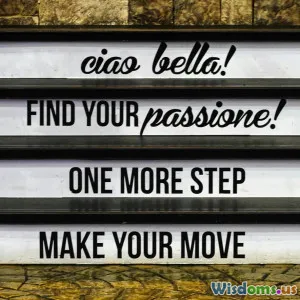
The Hero’s Journey in Everyday Life
9 min read Discover how the timeless Hero’s Journey myth reflects and inspires our everyday challenges and growth. (0 Reviews)
The Hero’s Journey in Everyday Life
Our lives, in many ways, resemble the anatomy of myths and legends—stories that have endured for millennia because they resonate deeply with what it means to be human. Among these narratives, the Hero’s Journey stands out as a universal template for transformation and adventure. Originally outlined by mythologist Joseph Campbell, this framework reveals profound insights not only into epic tales but also into our personal experiences. But can such grand, mythic motifs really reflect our ordinary lives? The answer is a resounding yes.
Understanding the Hero’s Journey: A Brief Overview
Joseph Campbell, in his seminal work The Hero with a Thousand Faces (1949), distilled myths from cultures worldwide into a singular narrative cycle. This cycle includes stages such as:
- The Call to Adventure
- Crossing the Threshold
- Trials and Allies
- The Abyss or Supreme Ordeal
- Transformation and Reward
- Return with the Elixir
While this structure was initially applied to mythic heroes like Odysseus or King Arthur, Campbell believed it reflected an archetype embedded in the human psyche—the path of growth and self-discovery.
The Hero’s Journey as a Metaphor for Everyday Challenges
The Call to Adventure in Modern Life
Everyday life throws countless “calls to adventure” our way. It might be changing careers, embarking on a new project, moving to a new city, or confronting a personal problem. For instance, when Malala Yousafzai chose to advocate for girls’ education despite extreme danger, she answered a daunting call to adventure, displaying the courage of mythic heroes.
Nearly all transformative experiences start with an initial, often uncomfortable awareness that something must change—this is the hero’s moment of refusal or acceptance.
Crossing the Threshold: Embracing the Unknown
Taking that first definitive step out of comfort zones parallels the hero’s crossing of the threshold. Entrepreneurs, for example, leave behind stable jobs to pursue risky startups. Sara Blakely, founder of Spanx, exemplified this when she risked her savings and social security job to create a new category of apparel. This threshold crossing is rarely easy, fraught with uncertainty. But it is essential for growth.
Trials, Allies, and Ordeals: The Growth Process
Every hero confronts trials, faces setbacks, and gains allies—be they friends, mentors, or colleagues. In our lives, these can be the obstacles in complex projects, struggles with mental health, or navigating school or workplace dynamics. Consider patients recovering from illness: the phases of struggle, therapy, support networks, and incremental progress mimic these heroic tests.
The Abyss and Supreme Ordeal: Facing Our Darkest Moments
One of the most compelling parts of the Hero’s Journey is the abyss, the ordeal that tests the hero to their core. In real life, these are moments such as losing a loved one, battling addiction, or confronting personal failure. Christopher Reeve’s life after his spinal injury reflects a heroic ordeal—transforming despair into advocacy and inspiration.
Psychological research supports this: examples show post-traumatic growth where individuals emerge stronger after intense suffering, a process perfectly aligned with the mythic journey.
Transformation and Reward: The New Self Emerges
Surviving the ordeal often sparks a transformation. Heroines and heroes return changed, sometimes gaining new wisdom or gifts—qualities that enrich themselves and others. In our lives, this can manifest as newfound confidence, empathy, or skills. Oprah Winfrey’s trajectory—from adversity to global influence—exemplifies the hero’s transformative reward.
The Return with the Elixir: Sharing Wisdom
In the final stage, the hero returns to ordinary life but often brings back knowledge or healing that benefits the larger community. This mirrors how people who have overcome hardship often become mentors, teachers, or activists, sharing their insights to help others navigate their own journeys.
Why the Hero’s Journey Remains Relevant Today
Psychological Resonance
The Hero’s Journey taps into archetypes described by Carl Jung—universal patterns within the collective unconscious. These archetypes help individuals make sense of chaotic internal experiences. Studies in psychotherapy use narrative frameworks similar to the Hero’s Journey to aid healing by reshaping how people understand their life stories.
Cultural Narratives and Media
From Star Wars to The Lion King, Hollywood leverages this mythic structure because it naturally captivates human emotion. Recognizing these patterns in our own lives can empower us by connecting personal struggles to a larger human saga.
Practical Application in Self-Development
Coaches and educators frequently employ the Hero’s Journey model. It helps set a roadmap for personal development, inspiring clients to see challenges as stepping stones rather than dead ends. Educational programs, like Joseph Campbell Foundation initiatives, emphasize this journey as a tool for empathy and resilience.
Practical Steps to Embody the Hero’s Journey in Daily Life
- Recognize Your Call: Stay alert to moments urging change or growth.
- Embrace the Unknown: Push beyond comfort zones consciously.
- Seek Allies: Build networks of support to endure challenges.
- Confront Fear: Accept and face your ‘abyss’—seek professional help if needed.
- Reflect on Transformation: Journal or meditate to embody new insights.
- Share Your Story: Become a ‘guide’ to others navigating their journeys.
Conclusion: From Myth to Meaning
The Hero’s Journey isn’t just an ancient storytelling device; it’s a mirror to the complexity and possibility of human life. Every person embarks on challenges that mirror the epic quests of mythical heroes, albeit on a personal scale. By understanding this structure, we can approach life’s trials with intention, courage, and hope. In doing so, we transform from mere sufferers of circumstance into active creators of our stories—heroes in our own right.
As Joseph Campbell famously said, “The cave you fear to enter holds the treasure you seek.” Our daily lives offer countless caves and, with awareness, a chance to find our treasure and share it with the world.
References:
- Campbell, J. (1949). The Hero with a Thousand Faces.
- Neimeyer, R. A. (2006). Role of Narrative in the Construction of the Self.
- Tedeschi, R. G., & Calhoun, L. G. (1996). Posttraumatic Growth Inventory.
- Joseph Campbell Foundation, www.jcf.org
- Interviews and biographies of Malala Yousafzai, Sara Blakely, Christopher Reeve, Oprah Winfrey
Rate the Post
User Reviews
Popular Posts



















